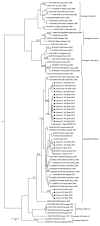Survey of Crimean-Congo Hemorrhagic Fever Enzootic Focus, Spain, 2011-2015
- PMID: 31107219
- PMCID: PMC6537724
- DOI: 10.3201/eid2506.180877
Survey of Crimean-Congo Hemorrhagic Fever Enzootic Focus, Spain, 2011-2015
Abstract
During 2011-2015, we conducted a Crimean-Congo hemorrhagic fever virus (CCHFV) survey in captured ticks that were feeding mainly on wild and domestic ungulates in Spain, where presence of this virus had been reported previously. We detected CCHFV RNA in Hyalomma lusitanicum and H. marginatum ticks for 3 of the 5 years. The rate of infected ticks was 2.78% (44/1,579), which was similar to those for other countries in Europe with endemic foci for CCHFV (Kosovo, Bulgaria, and Albania). These data confirm the established spread of CCHFV into western Europe. Phylogenetic study of the small RNA segment showed Africa-3 clade as the only genotype identified, although we observed cocirculation of genetic variants during 2011 and 2015. We could not rule out genetic reassortments because of lack of sequence data for the medium and large RNA segments of the virus genome.
Keywords: CCHFV; Crimean Congo hemorrhagic fever virus; Crimean-Congo hemorrhagic fever; Hyalomma spp. ticks; Spain; endemic circulation; enzootic focus; molecular epidemiology survey; phylogenetic analysis; reverse transcription PCR; tick-borne infections; vector-borne infections; viruses; zoonoses.
Figures


References
-
- World Health Organization. Crimean-Congo hemorrhagic fever. Fact sheet no. 208; 2013. [cited 2019 Mar 6]. http://www.who.int/mediacentre/factsheets/fs208/en
Publication types
MeSH terms
LinkOut - more resources
Full Text Sources
Medical
Miscellaneous

